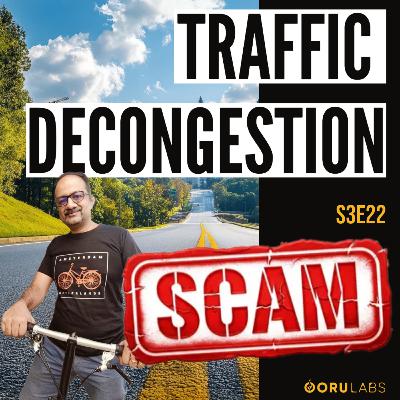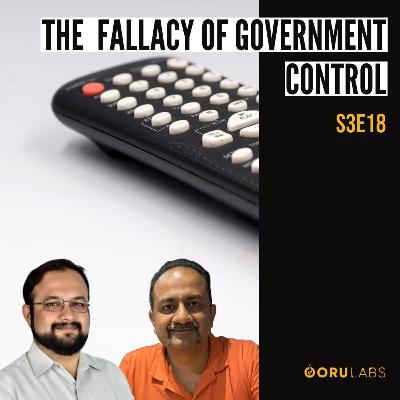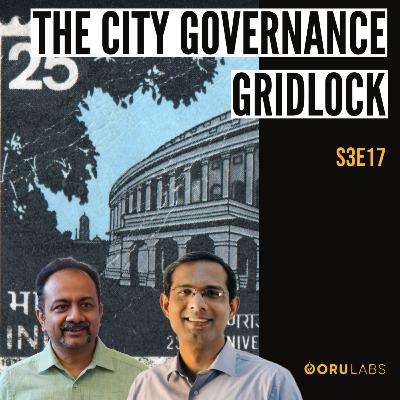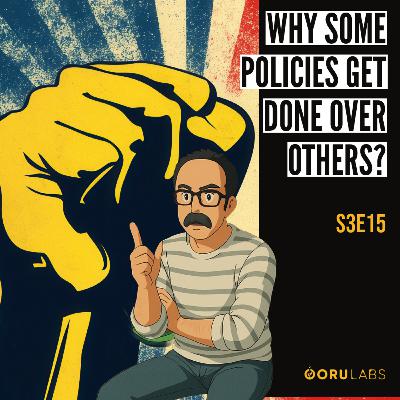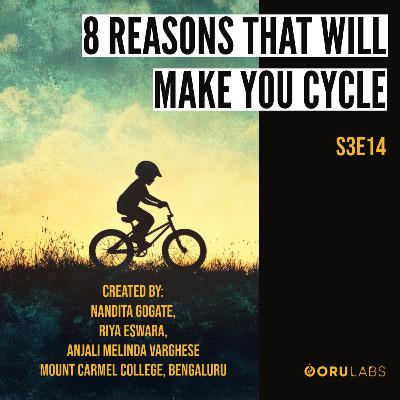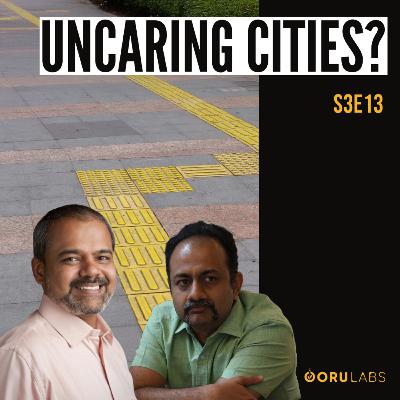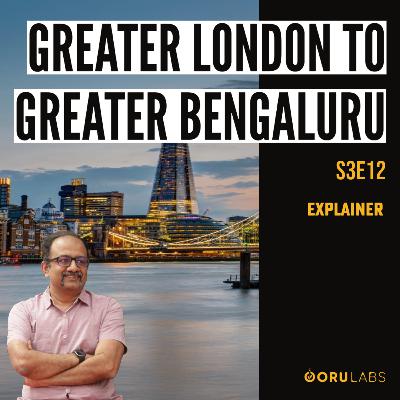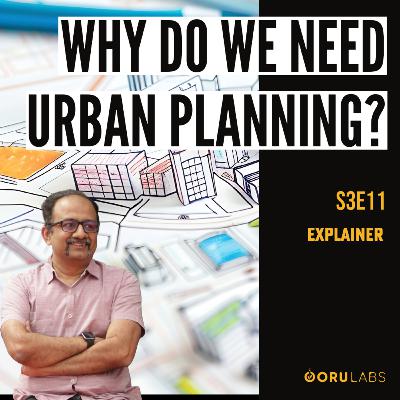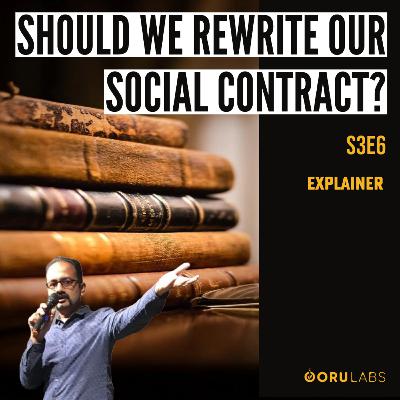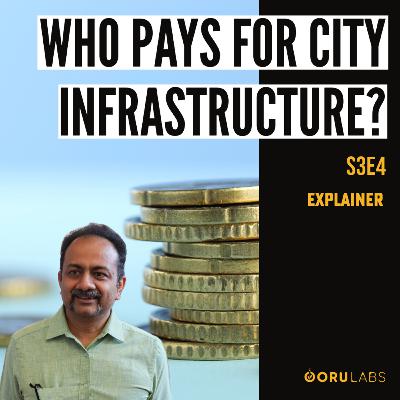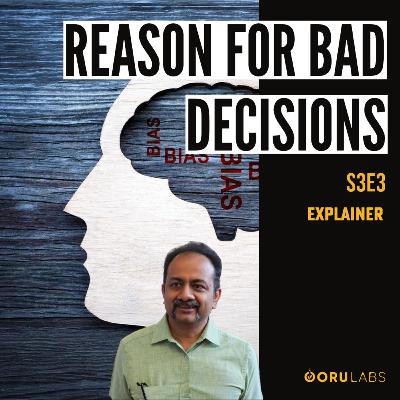Discover The OoruLabs Podcast
The OoruLabs Podcast

The OoruLabs Podcast
Author: Sathya Sankaran
Subscribed: 3Played: 6Subscribe
Share
© Sathya Sankaran
Description
Welcome to the OoruLabs podcast. The soapbox for Urban Sustainability. We will check out hot topics, trending news in the areas of urban transport, waste, energy, water, the new digital economy and its implications for urban living.
121 Episodes
Reverse
***Support the podcast, become a member: https://www.youtube.com/channel/UCksnReFEAAK47cTVZBVQJrw/join SummaryIn this episode, Sathya Sankaran discusses the complexities of urban traffic congestion, emphasizing that decongestion is not feasible for private vehicles without significant penalties. He introduces the concept of Jevons Paradox, explaining how increased efficiency in resource use can lead to greater overall demand. The conversation shifts to the cultural influences on transportation choices and the need for governance reform to improve infrastructure. The role of the private sector in urban development is highlighted, along with the importance of cultural norms in fostering civic responsibility and sustainable practices.Keywordsurban traffic, congestion, Jevons paradox, public transport, governance, infrastructure, cultural norms, urban development, private sector, civic responsibilityTakeawaysDecongesting traffic for private vehicles is impossible without penalties.Jevons Paradox illustrates how efficiency can increase demand.Cultural understanding is crucial for addressing urban mobility issues.Governance reform is essential for effective infrastructure management.Private sector involvement can enhance urban development.Civic responsibility is influenced by cultural norms.Efficient transport modes should be prioritized over private vehicles.India's tax-to-GDP ratio limits infrastructure investment.Poor management accounts for the majority of inefficiencies in government.Cultural change is necessary for sustainable urban practices.Sound Bites"India's tax to GDP ratio is around 18%.""The answer could lie in cultural change.""Will we stop throwing trash on the roads?"Chapters00:00 Understanding Traffic Congestion and Urban Mobility02:50 The Role of Governance in Urban Infrastructure04:59 Cultural Influences on Urban Planning and Infrastructure07:55 Challenges in Government Efficiency and Accountability10:39 The Future of Urban Infrastructure and Public-Private Partnerships13:10 Cultural Norms and Their Impact on Urban Reform————Stock video and picture credits to various contributors. All rights belong to respective owners. Show notes generated by Riverside AI.—————Listen to other video-pods on this topic and subscribe to the channelSpotify link: https://open.spotify.com/show/6EYcxIPGW0UQvmkk67Ox0x?si=efbf1c2c47d449be Apple Podcasts link: https://podcasts.apple.com/us/podcast/the-oorulabs-podcast/id1682407685 YouTube link: YouTube.com/@oorulabs Website: https://podcast.oorulabs.com Join this WhatsApp community to receive updates on OoruLabs Podcast https://chat.whatsapp.com/HquObSYDOFz5DXP6TEh07W
***Support the podcast, become a member: https://www.youtube.com/channel/UCksnReFEAAK47cTVZBVQJrw/join SummaryThis conversation delves into the challenges and inefficiencies of public transport systems in India, particularly focusing on bus services. The discussion highlights the gap between the number of buses and the population's needs, the importance of smart route planning, and the need for a user-centric approach to improve service reliability and satisfaction. The role of technology and data-driven decision-making in optimizing bus operations is also emphasized, along with the potential for innovations in the sector.Keywordspublic transport, bus services, efficiency, user satisfaction, route planning, technology, data-driven decision making, India, transportation planning, electric busesTakeawaysMost Indian cities lack sufficient city buses for their population.Inefficient allocation of existing bus fleets affects service reliability.User satisfaction is often overlooked in public transport planning.Efficiency should prioritize user needs over mere productivity metrics.Route planning must consider peak hours and user demand.Public transport systems face conflicting objectives in service coverage.Technology investment alone is not enough to solve operational issues.Data-driven decision making is crucial for effective transport planning.User satisfaction metrics should be integrated into operational goals.Innovations in bus services can lead to improved public transport experiences.Sound Bites"Most Indian cities do not have enough city buses.""Are the bus routes efficient at all?""The reliability of service can be maintained?""There is no clear cut answer to this problem.""The decision making is ad hoc, reactive in nature.""We need to know where my travel demand is."Chapters00:00 The State of Public Transport in India03:07 Efficiency vs. User Satisfaction in Bus Services05:50 Challenges in Route Planning and Service Coverage09:07 Balancing Service Obligations and Operational Efficiency12:02 The Role of Technology in Bus Operations14:49 Data-Driven Decision Making in Public Transport18:09 User-Centric Approach to Public Transport20:56 Innovations and Future Directions in Bus Services————Stock video and picture credits to various contributors. All rights belong to respective owners. Show notes generated by Riverside AI.—————Listen to other video-pods on this topic and subscribe to the channelSpotify link: https://open.spotify.com/show/6EYcxIPGW0UQvmkk67Ox0x?si=efbf1c2c47d449be Apple Podcasts link: https://podcasts.apple.com/us/podcast/the-oorulabs-podcast/id1682407685 YouTube link: YouTube.com/@oorulabs Website: https://podcast.oorulabs.com Join this WhatsApp community to receive updates on OoruLabs Podcast https://chat.whatsapp.com/HquObSYDOFz5DXP6TEh07W
***Support the podcast, become a member: https://www.youtube.com/channel/UCksnReFEAAK47cTVZBVQJrw/join SummaryIn this conversation, Nupur Ghuliani from Reap Benefit and Kaushik Ravi a Solve Ninja discusses the importance of empowering youth as change makers. The dialogue explores how engaging young people can transform citizen apathy into active participation in civic and environmental issues. Through the Solve Ninja initiative, young individuals are encouraged to identify and solve problems in their communities, fostering a sense of agency and responsibility. Real-life stories of Solve Ninjas illustrate the impact of these initiatives, showcasing how youth can drive meaningful change. The conversation concludes with advice for aspiring change makers, emphasizing the importance of starting small and being accountable in their efforts.Keywordsyouth empowerment, change makers, civic engagement, environmental advocacy, student initiatives, community solutions, Reap Benefit, Solve Ninjas, social impact, youth activismTakeawaysThe future of the country relies on youth involvement.Engaging young people can combat citizen apathy.Youth are more open to new ideas and learning.Empowering youth gives them agency in their change-making journey.The Solve Ninja initiative aims to create 10 million student changemakers.Real-life projects can have a significant impact on communities.Problem-solving frameworks help youth engage with real issues.Starting small can lead to larger community changes.Accountability begins at an individual level.The act of creating solutions enhances learning and engagement.Sound Bites“They are more willing to listen and learn.""Start small and be accountable.""Start with your own community for change."Chapters00:00 Empowering Youth as Change Makers02:42 Engaging with Young People: A New Approach05:15 The Solve Ninja Initiative08:12 Real-Life Impact Stories of Solve Ninjas11:03 The Journey of a Solve Ninja13:51 Building Solutions and Community Engagement17:06 Advice for Aspiring Change Makers19:48 Becoming a Solve Ninja: How to Get Involved————Stock video and picture credits to various contributors. All rights belong to respective owners. Show notes generated by Riverside AI.—————Listen to other video-pods on this topic and subscribe to the channelSpotify link: https://open.spotify.com/show/6EYcxIPGW0UQvmkk67Ox0x?si=efbf1c2c47d449be Apple Podcasts link: https://podcasts.apple.com/us/podcast/the-oorulabs-podcast/id1682407685 YouTube link: YouTube.com/@oorulabs Website: https://podcast.oorulabs.com Join this WhatsApp community to receive updates on OoruLabs Podcast https://chat.whatsapp.com/HquObSYDOFz5DXP6TEh07W
***Support the podcast, become a member: https://www.youtube.com/channel/UCksnReFEAAK47cTVZBVQJrw/join Keywordscrowd management, pre-planning, real-time monitoring, data utilization, misinformation, crowd safety, event management, psychological triggers, crowd disasters, safety protocolsSummaryThe conversation delves into the complexities of crowd management, emphasizing the need for pre-planning, real-time monitoring, and the impact of misinformation on crowd behavior. Prof. Ashish Verma discusses various techniques and technologies that can enhance crowd safety, including simulation frameworks and data utilization. The importance of clear guidelines and protocols for managing large gatherings is highlighted, along with the psychological factors that can trigger crowd disasters. The discussion concludes with recommendations for improving crowd management practices in future events.TakeawaysCrowd management requires a scientific approach.Pre-planning can significantly reduce crowd-related risks.Real-time data can enhance crowd monitoring and safety.Misinformation can escalate crowd tensions and lead to disasters.Clear guidelines are essential for effective crowd management.Crowds behave like a pressured system; sudden releases can cause chaos.Single file movement can help contain crowd dynamics.Scarcity of resources can lead to panic in crowds.Effective communication is key to managing crowd behavior.Protocols and guidelines must be established for crowd events.Sound bites"Crowd management is a complex science.""Big data events can help monitor crowds.""We need clear guidelines for crowd events."Chapters00:00 Understanding Crowd Management: A Complex Science02:53 The Role of Technology in Crowd Management07:01 Pre-Planning for Crowd Events10:27 Real-Time Monitoring and Response17:45 The Impact of Information and Misinformation21:31 Improving Crowd Management Protocols————Stock video and picture credits to various contributors. All rights belong to respective owners. Show notes generated by Riverside AI.—————Listen to other video-pods on this topic and subscribe to the channelSpotify link: https://open.spotify.com/show/6EYcxIPGW0UQvmkk67Ox0x?si=efbf1c2c47d449be Apple Podcasts link: https://podcasts.apple.com/us/podcast/the-oorulabs-podcast/id1682407685 YouTube link: YouTube.com/@oorulabs Website: https://podcast.oorulabs.com Join this WhatsApp community to receive updates on OoruLabs Podcast https://chat.whatsapp.com/HquObSYDOFz5DXP6TEh07W
***Support the podcast, become a member: https://www.youtube.com/channel/UCksnReFEAAK47cTVZBVQJrw/join SummaryIn this episode of the OoruLabs podcast, Sathya Sankaran discusses with Alok Prasanna Kumar of Vidhi legal, the recent changes in Bengaluru's governance structure. The Greater Bengaluru Governance Act proposes to divide Bengaluru into multiple corporations and establish a Greater Bengaluru Authority (GBA) headed by the Chief Minister. While the intention of the Greater Bengaluru Governance Act is to improve urban governance, the episode highlights potential pitfalls and challenges associated with this new structure, including concerns about the GBA's powers and the implications for local governance.-KeywordsBengaluru, Greater Bengaluru Authority, urban governance, municipal corporation, 74th amendment, city management, governance challenges—TakeawaysBengaluru is set to be divided into multiple corporations.The Greater Bengaluru Governance Bill aims to improve urban governance.The GBA will be headed by the Chief Minister of Karnataka.The bill may contradict the 74th amendment of the constitution.There are concerns about the GBA's powers over local corporations.Ward committees are intended to decentralize governance.The GBA's financial control raises questions about local autonomy.The bill's implementation plan is still unclear.There are options for constitutional challenges to the bill.The future of Bengaluru's governance remains uncertain.——Sound Bites"What can really happen?"———Chapters00:00 Introduction to Bengaluru's Governance Changes02:59 Understanding the Greater Bengaluru Authority (GBA)06:04 Implications and Future of Bengaluru's Governance————Stock video and picture credits to various contributors. All rights belong to respective owners. Show notes generated by Riverside AI.—————Listen to other video-pods on this topic and subscribe to the channelSpotify link: https://open.spotify.com/show/6EYcxIPGW0UQvmkk67Ox0x?si=efbf1c2c47d449be Apple Podcasts link: https://podcasts.apple.com/us/podcast/the-oorulabs-podcast/id1682407685 YouTube link: YouTube.com/@oorulabs Website: https://podcast.oorulabs.com Join this WhatsApp community to receive updates on OoruLabs Podcast https://chat.whatsapp.com/HquObSYDOFz5DXP6TEh07W
***Support the podcast, become a member: https://www.youtube.com/channel/UCksnReFEAAK47cTVZBVQJrw/join SummaryIn this episode of the OoruLabs Podcast, host Sathya Sankaran discusses with Srikanth Vishwanathan, CEO or Janaagraha, the alarming state of urban governance in India, highlighting the rapid growth of city populations juxtaposed with the inefficiencies of local governments. The conversation delves into the implications of the 74th Amendment, the lack of elected representatives in urban local bodies, and the mismanagement of city finances. The episode emphasizes the need for structured citizen engagement and the empowerment of local governance bodies to address these challenges effectively.Link to the CAG reports - https://cag.gov.in/en/study-reports -Keywordsurban governance, local government, 74th Amendment, city administration, citizen engagement, urban local bodies, city finances, India, urban development, local elections—TakeawaysCity populations in India are growing rapidly, yet cities are in disarray.Local governments are failing due to poor performance and lack of accountability.The 74th Amendment aimed to empower local governance but has seen limited success.Over 60% of urban local bodies lack elected councils, hindering effective governance.City finances are mismanaged, with a heavy reliance on state and central grants.Only a small percentage of city revenues are generated locally, limiting autonomy.Many cities struggle to utilize available funds effectively for development.The lack of elected representatives leads to a disconnect between citizens and local governance.Empowering local governance bodies is crucial for improving urban management.There is a need for continuous citizen engagement to foster better governance.——Sound Bites"City finances are the most mismanaged."———Chapters00:00 The Urban Crisis in India02:59 The 74th Amendment and Local Governance05:49 Challenges in City Administration and Finance————Stock video and picture credits to various contributors. All rights belong to respective owners. Show notes generated by Riverside AI.—————Listen to other video-pods on this topic and subscribe to the channelSpotify link: https://open.spotify.com/show/6EYcxIPGW0UQvmkk67Ox0x?si=efbf1c2c47d449be Apple Podcasts link: https://podcasts.apple.com/us/podcast/the-oorulabs-podcast/id1682407685 YouTube link: YouTube.com/@oorulabs Website: https://podcast.oorulabs.com Join this WhatsApp community to receive updates on OoruLabs Podcast https://chat.whatsapp.com/HquObSYDOFz5DXP6TEh07W
***Support the podcast, become a member: https://www.youtube.com/channel/UCksnReFEAAK47cTVZBVQJrw/join SummaryIn this episode of the OoruLabs Podcast, host Sathya Sankaran explores with Ashwin Mahesh, the challenges of local governance and the principle of subsidiarity, emphasizing the need for citizen engagement in development. The conversation highlights the cultural differences in development approaches, the importance of building collaborative relationships with government, and innovative models for empowering communities to drive local change. -Keywordslocal governance, subsidiarity, citizen engagement, community development, public infrastructure, neighborhood improvement, civic participation, government accountability, social change, urban planning—TakeawaysGovernment projects often fail to address local needs.Subsidiarity advocates for local decision-making.Cultural factors influence the pace of development.Citizen engagement is crucial for effective governance.A collaborative relationship with government is essential.Community involvement can fill gaps in public services.Innovative models can empower local change.Funding should support community-driven initiatives.Engaging citizens can lead to better outcomes.Neighborhood improvement requires a collective effort.——Sound Bites"What control do you have as a resident?""Subsidiarity means decisions should be made locally.""We need a narrative around what people are doing.""The gap is in the lack of engaging conversation.""We need to enable more people to express themselves."———Chapters00:00 Understanding Local Governance Challenges03:06 The Principle of Subsidiarity in Governance06:04 Cultural Differences in Development Approaches09:02 The Role of Citizens in Development11:56 Building a Collaborative Relationship with Government14:50 Empowering Communities for Local Change18:13 Innovative Models for Neighborhood Improvement————Stock video and picture credits to various contributors. All rights belong to respective owners. Show notes generated by Riverside AI.—————Listen to other video-pods on this topic and subscribe to the channelSpotify link: https://open.spotify.com/show/6EYcxIPGW0UQvmkk67Ox0x?si=efbf1c2c47d449be Apple Podcasts link: https://podcasts.apple.com/us/podcast/the-oorulabs-podcast/id1682407685 YouTube link: YouTube.com/@oorulabs Website: https://podcast.oorulabs.com Join this WhatsApp community to receive updates on OoruLabs Podcast https://chat.whatsapp.com/HquObSYDOFz5DXP6TEh07W
***Support the podcast, become a member: https://www.youtube.com/channel/UCksnReFEAAK47cTVZBVQJrw/join In this episode of the OoruLabs, India’s premier urban affairs podcast, host Sathya Sankaran explores the complexities of political decision-making through the lens of public choice theory and the Overton window. The discussion delves into how politicians prioritize self-interest and popularity, the dynamics of policy acceptance, and the gradual societal changes that influence what is considered normative. The episode emphasizes the importance of civil society and market actions in shifting public opinion and making radical ideas more acceptable.-Keywordspublic choice theory, Overton window, creeping normality, political decision-making, societal change, policy acceptance, self-interest, civil society, popular opinion, political action—TakeawaysPoliticians often prioritize self-interest over public good.Public choice theory explains political behavior as self-serving.Popularity is crucial for politicians to remain in power.The Overton window defines what policies are acceptable.Policies outside the Overton window risk losing support.Creeping normality allows gradual acceptance of change.Societal action is essential for mainstreaming issues.Convincing politicians requires building grassroots support.Civil society plays a key role in shifting norms.Radical ideas need to become popular to be implemented.——Sound Bites"What does this mean?"———Chapters00:00 Understanding Political Decision-Making03:11 The Overton Window and Policy Acceptance05:55 Creeping Normality and Societal Change————Stock video and picture credits to various contributors. All rights belong to respective owners. Show notes generated by Riverside AI.—————Listen to other video-pods on this topic and subscribe to the channelSpotify link: https://open.spotify.com/show/6EYcxIPGW0UQvmkk67Ox0x?si=efbf1c2c47d449be Apple Podcasts link: https://podcasts.apple.com/us/podcast/the-oorulabs-podcast/id1682407685 YouTube link: YouTube.com/@oorulabs Website: https://podcast.oorulabs.com Join this WhatsApp community to receive updates on OoruLabs Podcast https://chat.whatsapp.com/HquObSYDOFz5DXP6TEh07W
***Support the podcast, become a member: https://www.youtube.com/channel/UCksnReFEAAK47cTVZBVQJrw/join SummaryThis conversation explores the evolution of urban mobility in Bengaluru, highlighting the shift from cycling to motor vehicles and the resulting traffic congestion. It emphasizes the need for better infrastructure to support cycling as a viable mode of transport, presenting Pedaluru as a community-driven initiative aimed at promoting cycling for health, sustainability, and improved urban living. The discussion underscores the benefits of cycling, including time savings, space efficiency, and environmental impact, while calling for collective action to transform Bengaluru into a cycling-friendly city.-Keywordsurban mobility, cycling, Bengaluru, Pedaluru, sustainable transport, community, infrastructure, health, environment, traffic—TakeawaysMost of us began navigating the road with a cycle.India has only an 8% penetration of cars.We have become the traffic we complain about.The cycle becomes a catalyst of change.Bengaluru has a massive potential to be the cycling capital.Cyclists can save up to 30% of commute time.One car takes up as much space as 10 bicycles.Cycling reduces heart risk by about 50%.If only 10% of our citizens switched to bicycling, it would offset 1 lakh tonnes of CO2.Join Pedaluru, cycle for Nammauru.——Sound Bites"You are moving Bengaluru."———Chapters00:00 The Evolution of Urban Mobility02:55 The Case for Cycling in Bengaluru05:47 Pedaluru: A Movement for Change08:39 Building a Cycling Community————Stock video and picture credits to various contributors. All rights belong to respective owners. Show notes generated by Riverside AI.—————Listen to other video-pods on this topic and subscribe to the channelSpotify link: https://open.spotify.com/show/6EYcxIPGW0UQvmkk67Ox0x?si=efbf1c2c47d449be Apple Podcasts link: https://podcasts.apple.com/us/podcast/the-oorulabs-podcast/id1682407685 YouTube link: YouTube.com/@oorulabs Website: https://podcast.oorulabs.com Join this WhatsApp community to receive updates on OoruLabs Podcast https://chat.whatsapp.com/HquObSYDOFz5DXP6TEh07W
***Support the podcast, become a member: https://www.youtube.com/channel/UCksnReFEAAK47cTVZBVQJrw/join In this episode of OoruLabs, India’s premier Urban Affairs podcast, Sathya Sankaran, explores the multifaceted aspects of disability in society, focusing on the prevalence of disabilities, the role of technology in enhancing accessibility, government initiatives like the UDID card, and the challenges faced in urban environments. The discussion emphasizes the importance of empathy, awareness, and the need for inclusive policies to support individuals with disabilities. The conversation delves into the various challenges and solutions surrounding accessibility for people with disabilities, focusing on urban planning, public transportation, and the need for a cultural shift in mindset towards inclusion. It highlights the importance of implementing effective accessibility measures in public spaces and the role of technology in facilitating these changes. The discussion also emphasizes the need for advocacy and awareness to empower individuals with disabilities to demand their rights and access. This conversation explores the innovative solutions for improving accessibility in public spaces and education, focusing on the development of an app that allows users to audit and assess the accessibility of various locations. It discusses the challenges faced in inclusive education, the role of schools, and the importance of creating awareness and empathy towards individuals with disabilities. The dialogue emphasizes the need for data-driven approaches to enhance urban accessibility and the collective responsibility to foster an inclusive environment.-Keywordsdisability, accessibility, technology, government policy, urban planning, inclusion, assistive devices, social justice, community support, awareness, accessibility, public transportation, disability rights, urban planning, inclusive design, technology solutions, accessibility audit, physical disabilities, mindset change, Yes to Access, accessibility, education, technology, urban planning, disability, inclusion, app development, public spaces, awareness, empathy——Sound Bites"Our footpaths, it's a story best left to itself.""There are places where it lacks in implementation.""Only two of them had ramps.""We need to get them to demand for those rights.""We built an app that can use smartphone features.""We hope to make this a digital public good.""We've got about 10,000 places assessed so far.""Degrees mean nothing, certificates mean nothing.""Empathy is what we need to show to people.""Let's make that information available to people.""Thanks a bunch for coming on this show."———Chapters00:00 Understanding Disability in Society06:03 The Role of Technology in Accessibility11:55 Government Initiatives and Challenges18:01 The State of Urban Accessibility18:20 Implementation Challenges in Accessibility21:14 Public Transportation Accessibility Audit23:34 Tech Solutions for Accessibility26:32 Addressing Physical Disabilities30:55 Changing Mindsets for Inclusion35:08 Yes to Access: A Tech Solution37:23 Innovative Accessibility Solutions39:17 Data-Driven Accessibility Audits41:50 Challenges in Inclusive Education46:11 The Role of Schools in Inclusion49:00 Future of Urban Accessibility50:20 Creating Awareness and Empathy————Stock video and picture credits to various contributors. All rights belong to respective owners. Show notes generated by Riverside AI.—————Listen to other video-pods on this topic and subscribe to the channelSpotify link: https://open.spotify.com/show/6EYcxIPGW0UQvmkk67Ox0x?si=efbf1c2c47d449be Apple Podcasts link: https://podcasts.apple.com/us/podcast/the-oorulabs-podcast/id1682407685 YouTube link: YouTube.com/@oorulabs Website: https://podcast.oorulabs.com Join this WhatsApp community to receive updates on OoruLabs Podcast https://chat.whatsapp.com/HquObSYDOFz5DXP6TEh07W
***Support the podcast, become a member: https://www.youtube.com/channel/UCksnReFEAAK47cTVZBVQJrw/join In this episode of OoruLabs, India’s premier Urban Affairs podcast, Sathya Sankaran discusses the challenges of urban planning in Bengaluru, highlighting the limitations of traditional master plans and advocating for a more dynamic, local approach to city management. He emphasizes the need for integrated land use and transport planning, the importance of citizen engagement, and the necessity of a cultural shift within government bureaucracy to prioritize the needs of citizens over vested interests.-Keywordsurban planning, master plans, Bengaluru, local governance, transport integration, city management, infrastructure, citizen engagement, government bureaucracy, sustainable cities—TakeawaysLess than 19% of Bengaluru's master plan has been executed.Many cities have moved away from rigid master plans.Dynamic local planning can better address urban needs.London's planning model integrates land use and transport.Bengaluru lacks a cohesive planning authority.Government bureaucracy often hinders effective urban planning.Citizen engagement is crucial for successful governance.High-performing individuals can improve team productivity.A regional approach is needed for infrastructure planning.Customer-centric governance is essential for quality of life.——Sound Bites"What takes the place of master plans?""London evolved to a dynamic planning model."———Chapters00:00 The Limitations of Master Planning in Urban Development10:41 Dynamic Local Planning: A New Approach to Urban Management————Stock video and picture credits to various contributors. All rights belong to respective owners. Show notes generated by Riverside AI.—————Listen to other video-pods on this topic and subscribe to the channelSpotify link: https://open.spotify.com/show/6EYcxIPGW0UQvmkk67Ox0x?si=efbf1c2c47d449be Apple Podcasts link: https://podcasts.apple.com/us/podcast/the-oorulabs-podcast/id1682407685 YouTube link: YouTube.com/@oorulabs Website: https://podcast.oorulabs.com Join this WhatsApp community to receive updates on OoruLabs Podcast https://chat.whatsapp.com/HquObSYDOFz5DXP6TEh07W
***Support the podcast, become a member: https://www.youtube.com/channel/UCksnReFEAAK47cTVZBVQJrw/join This episode of OoruLabs, India’s premier Urban Affairs podcast explainer series explores the complexities of urban planning, its historical evolution, and the challenges faced by modern cities, particularly in India. The host, Sathya Sankaran, discusses the importance of urban planning in enhancing the quality of life, the historical context of city development, and the shift towards mixed-use zoning. The conversation also addresses the debate over master plans and the effectiveness of cities that operate without them.-Keywordsurban planning, city development, historical context, modern practices, challenges, livability, zoning, master plans, Indian cities, urbanization—TakeawaysUrban planning is crucial for improving quality of life.Historical cities were often unplanned but had some structure.The Industrial Revolution led to massive urbanization and chaos.The garden city model aimed to combine the best of urban and rural living.Zoning is essential for organizing urban spaces effectively.Mixed-use zoning can reduce reliance on vehicles.Planning should consider local needs and context.Many successful cities operate without formal master plans.The balance between planning and local character is vital.Understanding urban planning can lead to better city living.——Sound Bites"Not having any plan might be total anarchy."———Chapters00:00 The Importance of Urban Planning02:59 Historical Context of Urban Development05:57 Modern Urban Planning Practices09:02 Challenges and Future of Urban Planning————Stock video and picture credits to various contributors. All rights belong to respective owners. Show notes generated by Riverside AI.—————Listen to other video-pods on this topic and subscribe to the channelSpotify link: https://open.spotify.com/show/6EYcxIPGW0UQvmkk67Ox0x?si=efbf1c2c47d449be Apple Podcasts link: https://podcasts.apple.com/us/podcast/the-oorulabs-podcast/id1682407685 YouTube link: YouTube.com/@oorulabs Website: https://podcast.oorulabs.com Join this WhatsApp community to receive updates on OoruLabs Podcast https://chat.whatsapp.com/HquObSYDOFz5DXP6TEh07W
***Support the podcast, become a member: https://www.youtube.com/channel/UCksnReFEAAK47cTVZBVQJrw/join In this episode of the OoruLabs podcast, Sathya Sankaran discusses urban congestion and pollution, exploring the concept of negative externalities and the various methods to internalize these costs. He delves into the Pigovian tax, Coase theorem, and private solutions, highlighting the complexities and challenges in addressing these issues effectively.-Keywordsurban congestion, pollution, negative externalities, Pigovian tax, Coase theorem, private solutions, social cost, environmental policy, public goods, market failure—TakeawaysSevere congestion and pollution in cities prompt discussions on solutions.Negative externalities affect bystanders who bear the costs of others' actions.Private costs do not account for social costs, leading to market failures.Pigovian tax aims to internalize negative externalities for market efficiency.Achieving Pareto optimality is complex and requires careful calibration.Coase theorem suggests private negotiations can resolve disputes under certain conditions.Widespread pollution cannot always be addressed through private solutions alone.Private solutions can create perverse incentives if not regulated properly.Public goods often face free rider problems, complicating private solutions.Technological advancements can help public agencies address environmental issues.——Sound Bites"These affected parties are called bystanders.""Achieving Pareto optimality is hard work."———Chapters00:00 Understanding Urban Congestion and Pollution02:59 The Concept of Negative Externalities06:02 Methods to Internalize External Costs08:58 Exploring Private Solutions and Their Implications————Stock video and picture credits to various contributors. All rights belong to respective owners. Show notes generated by Riverside AI.—————Listen to other video-pods on this topic and subscribe to the channelSpotify link: https://open.spotify.com/show/6EYcxIPGW0UQvmkk67Ox0x?si=efbf1c2c47d449be Apple Podcasts link: https://podcasts.apple.com/us/podcast/the-oorulabs-podcast/id1682407685 YouTube link: YouTube.com/@oorulabs Website: https://podcast.oorulabs.com Join this WhatsApp community to receive updates on OoruLabs Podcast https://chat.whatsapp.com/HquObSYDOFz5DXP6TEh07W
***Support the podcast, become a member: https://www.youtube.com/channel/UCksnReFEAAK47cTVZBVQJrw/join In this episode of the OoruLabs podcast, Sathya Sankaran discusses the complexities of road expansion and traffic congestion, emphasizing that simply adding more road capacity is not a sustainable solution. He explores the concept of public goods, opportunity costs, and the law of induced demand, illustrating how increased road supply often leads to more traffic rather than alleviating it. The conversation shifts towards the importance of efficient road utilization and the need for a comprehensive infrastructure network that prioritizes various modes of transport, ultimately advocating for a rethinking of urban mobility strategies.-Keywordstraffic congestion, road expansion, public goods, opportunity cost, induced demand, urban mobility, infrastructure efficiency, transportation planning, environmental value, mobility alternatives—TakeawaysAdding road capacity is often seen as a simple solution.Roads are public goods, funded by taxes.Opportunity costs must be considered in road expansion.Induced demand can lead to more traffic despite increased road space.Efficiency of existing road space is crucial for urban planning.Urban planners should focus on mobility, not just transport.Infrastructure should connect all modes of transport effectively.A network approach to infrastructure is essential for success.Road prioritization should focus on safety and efficiency.Political interests often hinder effective transportation solutions.——Sound Bites"Why don't we unpack this issue today?""The law of induced demand kicks in."———Chapters00:00 The Illusion of Road Expansion03:10 Understanding Public Goods and Opportunity Costs05:56 The Law of Induced Demand09:12 Rethinking Road Utilization and Efficiency12:02 The Role of Infrastructure in Urban Mobility————Stock video and picture credits to various contributors. All rights belong to respective owners. Show notes generated by Riverside AI.—————Listen to other video-pods on this topic and subscribe to the channelSpotify link: https://open.spotify.com/show/6EYcxIPGW0UQvmkk67Ox0x?si=efbf1c2c47d449be Apple Podcasts link: https://podcasts.apple.com/us/podcast/the-oorulabs-podcast/id1682407685 YouTube link: YouTube.com/@oorulabs Website: https://podcast.oorulabs.com Join this WhatsApp community to receive updates on OoruLabs Podcast https://chat.whatsapp.com/HquObSYDOFz5DXP6TEh07W
***Support the podcast, become a member: https://www.youtube.com/channel/UCksnReFEAAK47cTVZBVQJrw/join In this episode of the OoruLabs podcast, Sathya Sankaran explores the reasons behind urban transport choices in India, the role of government in urban planning, and the implications of public choice theory. He discusses the rational ignorance of voters, the incentives that drive politicians, and the challenges of collective decision-making. The conversation emphasizes the importance of bridging information asymmetry to align individual and collective interests, ultimately advocating for a political agenda that prioritizes long-term collective outcomes.-Keywordsurban transport, public choice theory, government failure, voter ignorance, collective action, information asymmetry, political choices, urban planning, cycling, public interest—TakeawaysPublic transport is underutilized in India compared to other countries.Government failure can hinder effective urban planning.Public choice theory applies market principles to political decision-making.Voter ignorance is rational due to the low impact of individual votes.Politicians often prioritize self-interest over public good.The impossibility theorem suggests collective rationality is unattainable.Individual choices can conflict with collective interests.Information asymmetry can be bridged through community tools.Collective action requires deliberate effort and awareness.Creating a political agenda is essential for long-term outcomes.——Sound Bites"Why do we put up with dirty cities?""Tools can help bridge information gaps."———Chapters00:00 Understanding Urban Transport Choices01:01 The Role of Government in Urban Planning02:12 Public Choice Theory Explained03:39 Voter Ignorance and Political Choices06:01 Incentives and Government Spending08:23 The Impossibility Theorem in Collective Decision Making09:48 Bridging Information Asymmetry for Collective Good12:13 Creating a Political Agenda for Collective Outcomes————Stock video and picture credits to various contributors. All rights belong to respective owners. Show notes generated by Riverside AI.—————Listen to other video-pods on this topic and subscribe to the channelSpotify link: https://open.spotify.com/show/6EYcxIPGW0UQvmkk67Ox0x?si=efbf1c2c47d449be Apple Podcasts link: https://podcasts.apple.com/us/podcast/the-oorulabs-podcast/id1682407685 YouTube link: YouTube.com/@oorulabs Website: https://podcast.oorulabs.com Join this WhatsApp community to receive updates on OoruLabs Podcast https://chat.whatsapp.com/HquObSYDOFz5DXP6TEh07W
***Support the podcast, become a member:https://www.youtube.com/channel/UCksnReFEAAK47cTVZBVQJrw/join In this episode of the OoruLabs podcast, Sathya Sankaran talks about the second edition of the Nama raste event in Bengaluru with Pawan Munukutla of WRI India. It focuses on urban mobility challenges, community engagement, and the role of local organizations and the BBMP in improving transportation infrastructure. -KeywordsNamaraste, Bengaluru, mobility, community engagement, BBMP, urban planning, transportation, public transport, sustainable choices, citizen participation—TakeawaysThe Namaraste event aims to bring together various stakeholders for better mobility in Bengaluru.Community engagement is crucial for addressing urban mobility challenges.BBMP plays a significant role in leading initiatives for improved transportation.Understanding demand behavior is essential for effective urban planning.The first edition of Namaraste provided valuable data and insights into mobility issues.Creating walkable streets is a key focus for improving urban infrastructure.Citizen participation can help hold local authorities accountable.The event is open to all, encouraging diverse participation.Local organizations are vital in showcasing mobility solutions.Future discussions should include gender perspectives in mobility planning.——Sound Bites"This is the second edition of Namaraste.""We need to make streets safer for everyone.""It's open to all, including frustrated residents.""BBMP has been very excited about this."———Chapters00:00 Introduction to Namaraste Event02:57 Understanding Mobility Challenges in Bengaluru05:57 Community Engagement and Participation08:52 The Role of BBMP and Local Organizations11:56 Demand vs. Supply in Urban Mobility15:03 Future Directions and Community Impact————Stock video and picture credits to various contributors. All rights belong to respective owners. Show notes generated by Riverside AI.—————Listen to other video-pods on this topic and subscribe to the channelSpotify link:https://open.spotify.com/show/6EYcxIPGW0UQvmkk67Ox0x?si=efbf1c2c47d449be Apple Podcasts link:https://podcasts.apple.com/us/podcast/the-oorulabs-podcast/id1682407685 YouTube link:YouTube.com/@oorulabs Website:https://podcast.oorulabs.com Join this WhatsApp community to receive updates on OoruLabs Podcasthttps://chat.whatsapp.com/HquObSYDOFz5DXP6TEh07W
***Support the podcast, become a member: https://www.youtube.com/channel/UCksnReFEAAK47cTVZBVQJrw/join
In this episode of the Uru Labs podcast, Sathya Sankaran explores the evolution of government from monarchies to modern democratic systems, highlighting key political philosophers like Hobbes, Locke, Montesquieu, and Rousseau. The discussion delves into the social contract theory, the role of government in protecting individual rights, and the management of public goods. The episode concludes with a thought-provoking look at the future of governance in the age of artificial intelligence and the potential need for a new social contract.
-
Keywords
government, social contract, individual rights, public goods, political philosophy, Enlightenment, Hobbes, Locke, Rousseau, Montesquieu, AI governance
—
Takeaways
Governments have evolved from monarchies to democratic systems.
The Enlightenment period was crucial in shaping modern political thought.
Hobbes viewed humans as fundamentally evil, needing strong governance.
Locke introduced the idea of natural rights that governments must protect.
Montesquieu's separation of powers is foundational to modern governance.
Rousseau's social contract emphasizes the people's control over government.
Governments are tasked with managing public goods and collective action problems.
Market failures can arise from individual self-interest conflicting with public welfare.
The role of government should be limited to protecting rights and public goods.
The rise of AI may necessitate a reevaluation of the social contract.
——
Sound Bites
"What is their role? What should they do?"
"The government should not be solving it."
———
Chapters
00:00 The Evolution of Government
03:02 The Enlightenment and Political Philosophy
05:53 The Social Contract and Individual Rights
09:09 Government's Role in Public Goods
11:54 The Future of Governance and AI
————
Stock video and picture credits to various contributors. All rights belong to respective owners. Show notes generated by Riverside AI.
—————
Listen to other video-pods on this topic and subscribe to the channel
Spotify link: https://open.spotify.com/show/6EYcxIPGW0UQvmkk67Ox0x?si=efbf1c2c47d449be
Apple Podcasts link: https://podcasts.apple.com/us/podcast/the-oorulabs-podcast/id1682407685
YouTube link: YouTube.com/@oorulabs
Website: https://podcast.oorulabs.com
Join this WhatsApp community to receive updates on OoruLabs Podcast https://chat.whatsapp.com/HquObSYDOFz5DXP6TEh07W
***Support the podcast, become a member: https://www.youtube.com/channel/UCksnReFEAAK47cTVZBVQJrw/join
On, OoruLabs, India's premier urban issues podcast, Sathya Sankaran, host of the podcast, discusses the collective action problem, particularly in the context of urban congestion and pollution. He explains the tragedy of the commons, where individual self-interest leads to collective negative outcomes. The conversation explores potential solutions, including collectivization, market-driven approaches, and government intervention, emphasizing the need for a multifaceted strategy to address these pressing issues.
-
Keywords
collective action, tragedy of the commons, urban congestion, pollution, social cost, negative externality, market solutions, government intervention, collectivization, free rider problem
—
Takeaways
The tragedy of the commons illustrates how individual actions can lead to collective harm.
Collective action problems arise when individuals prioritize personal benefits over communal well-being.
Free riding becomes more prevalent as the size of the group increases, complicating collective efforts.
Collectivization can help mitigate free riding by fostering social norms and accountability.
Market solutions can incentivize positive behavior changes among individuals and organizations.
Government intervention is often necessary to address social costs and negative externalities.
Effective solutions require a combination of collectivization, market strategies, and government action.
Urban congestion and pollution are complex issues that need diverse approaches for resolution.
Understanding social costs is crucial for developing effective public policies.
Engaging communities in decision-making can enhance the effectiveness of solutions.
——
Sound Bites
"This is an urban example of tragedy of the commons."
"The government will step in to solve the problem."
"Which of these three approaches do you think will work?"
———
Chapters
00:00 Introduction
01:11 Understanding the Collective Action Problem
05:54 Exploring Solutions to the Tragedy of the Commons
06:39 Collectivisation
09:06 Using the markets
12:02 Government coercion
————
Stock video and picture credits to various contributors. All rights belong to respective owners. Show notes generated by Riverside AI.
—————
Listen to other video-pods on this topic and subscribe to the channel
Spotify link: https://open.spotify.com/show/6EYcxIPGW0UQvmkk67Ox0x?si=efbf1c2c47d449be
Apple Podcasts link: https://podcasts.apple.com/us/podcast/the-oorulabs-podcast/id1682407685
YouTube link: YouTube.com/@oorulabs
Website: https://podcast.oorulabs.com
Join this WhatsApp community to receive updates on OoruLabs Podcast https://chat.whatsapp.com/HquObSYDOFz5DXP6TEh07W
***Support the podcast, become a member: https://www.youtube.com/channel/UCksnReFEAAK47cTVZBVQJrw/join
On, OoruLabs, India's premier urban issues podcast, Sathya Sankaran, host of the podcast, explores the concept of public goods, their characteristics, and classifications. He explains the definitions of public, common, and private goods, emphasising the implications of these classifications in urban infrastructure and resource management. The discussion highlights the interplay between different types of goods and the role of government in provisioning common goods, while also raising questions about the valuation of depleting resources and the collective action problem.
-
Keywords
public goods, common goods, private goods, economics, excludability, rivalrousness, urban infrastructure, taxation, resource management, collective action
—
Takeaways
Public goods are defined by non-excludability and non-rivalrousness.
Excludability refers to the ability to prevent access to a good.
Rivalrousness means one person's use of a good reduces its availability for others.
Common goods are rivalrous but non-excludable, like roads.
Public goods are often provided by the government through taxation.
Natural resources are public goods but can be privatized when processed.
The classification of goods helps determine who pays for them.
The interplay between public, common, and private goods is complex.
Valuing depleting resources poses significant challenges.
Collective action problems need to be addressed for effective resource management.
——
Sound Bites
"Are they really public goods?"
———
Chapters
00:00 Understanding Public Goods
06:06 Classification of Goods and Their Implications
08:04 The Interplay of Public, Common, and Private Goods
————
Stock video and picture credits to various contributors. All rights belong to respective owners. Show notes generated by Riverside AI.
—————
Listen to other video-pods on this topic and subscribe to the channel
Spotify link: https://open.spotify.com/show/6EYcxIPGW0UQvmkk67Ox0x?si=efbf1c2c47d449be
Apple Podcasts link: https://podcasts.apple.com/us/podcast/the-oorulabs-podcast/id1682407685
YouTube link: YouTube.com/@oorulabs
Website: https://podcast.oorulabs.com
Join this WhatsApp community to receive updates on OoruLabs Podcast https://chat.whatsapp.com/HquObSYDOFz5DXP6TEh07W
***Support the podcast, become a member: https://www.youtube.com/channel/UCksnReFEAAK47cTVZBVQJrw/join
On, OoruLabs, India's premier urban issues podcast, Sathya Sankaran, host of the podcast, explores the impact of cognitive biases on decision-making, particularly in the context of road safety for pedestrians and cyclists. He explains four key biases: availability heuristic, anchoring bias, framing effect, and loss aversion, illustrating how these biases can lead to irrational choices that perpetuate unsafe conditions. The conversation also touches on the importance of understanding behavioural economics and social norms in addressing public infrastructure issues.
-
Keywords
road safety, cognitive biases, behavioural economics, heuristics, public infrastructure, decision making, availability heuristic, anchoring bias, framing effect, loss aversion
—
Takeaways
Road safety is often compromised by cognitive biases.
Heuristics can lead to poor decision-making regarding safety.
The availability heuristic causes overestimation of risks.
Anchoring bias affects how we perceive costs and value.
Framing can significantly influence our choices and perceptions.
Loss aversion makes people resistant to change, even for the better.
Understanding behavioral economics can help in making informed choices.
Social norms can perpetuate unsafe behaviors in communities.
Slow thinking is essential for overcoming biases.
Awareness of biases can lead to better public infrastructure decisions.
——
Sound Bites
"How the message is framed is very important."
"People are predictably irrational."
———
Chapters
00:00 Intro
01:19 Understanding Road Safety and Cognitive Biases
01:59 Availability Heuristic
03:45 Anchoring Bias
05:46 Framing Effect
07:44 Loss Aversion
10:36 Exploring Behavioral Economics and Social Norms
————
Stock video and picture credits to various contributors. All rights belong to respective owners. Show notes generated by Riverside AI.
—————
Listen to other video-pods on this topic and subscribe to the channel
Spotify link: https://open.spotify.com/show/6EYcxIPGW0UQvmkk67Ox0x?si=efbf1c2c47d449be
Apple Podcasts link: https://podcasts.apple.com/us/podcast/the-oorulabs-podcast/id1682407685
YouTube link: YouTube.com/@oorulabs
Website: https://podcast.oorulabs.com
Join this WhatsApp community to receive updates on OoruLabs Podcast https://chat.whatsapp.com/HquObSYDOFz5DXP6TEh07W


